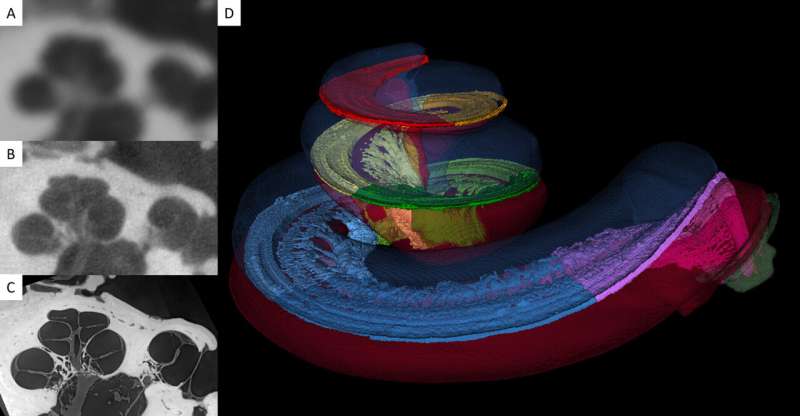This article has been reviewed according to Science X's editorial process and policies. Editors have highlighted the following attributes while ensuring the content's credibility:
fact-checked
peer-reviewed publication
trusted source
proofread
Customized hearing implants: How synchrotron imaging is changing the game

A Western University team has harnessed the bright light of the Canadian Light Source at the University of Saskatchewan (USask) to obtain highly detailed images of the structures in the inner ear responsible for transmitting sound signals to the brain. With these images, they've helped pioneer customized programming strategies for hearing implants.
Because of the cochlea's tiny, delicate, spiral-shaped structure, and the fact that it is encased in the densest bone in the human body, it is hard to use conventional techniques to study its anatomy and how implants interact with it. Synchrotron imaging changed the game by allowing scientists to visualize the cochlea in incredible detail—roughly at the scale of individual cells.
"We were able to obtain high-resolution data on the synchrotron, and then created beautiful three-dimensional images with our collaborators in Sweden," says Western University's Dr. Sumit Agrawal.
The team recently published the CLS-enabled mappings of 38 cochleae in the journal Laryngoscope. Agrawal says that this "gold standard data"—based on ultra-detailed imaging of the ear's anatomy—answers many questions in the field.
The maps the team created should make a huge difference to the sound quality of cochlear implants. As sound travels down the cochlea, different pitches land at different points in the structure for us to hear them. To tune the sound, an implant needs to match these points for that particular patient's anatomy. But without a map of the inner ear, cochlear implants can only be "one size fits all."
"It would be like listening to an out-of-tune piano. What we're doing now is actually mapping each of the electrodes to tune the piano for each individual patient."
By combining high-resolution imaging from the Bio-Medical Imaging and Therapy (BMIT) facility at the CLS with the team's deep learning algorithms, researchers can now create customized maps that match the unique anatomy of each patient's cochlea. The deep-learning algorithm, too, was partly trained on 3D images produced at the CLS.
The team has already begun applying this data to patients with cochlear implants, and published a small pilot study using both customized and standard programming. The personally "tuned" implants showed promising results, providing the data needed to proceed with the randomized controlled trial currently underway at Western University and the University of North Carolina.
"The fact that we were able to extract the anatomy from the synchrotron, create a new equation, apply it to patients and improve their performance was really exciting for us," says Agrawal.
"Although we have already started applying this translational 'bench-to-bedside' research in patients, we are not going to stop using the synchrotron. There are so many other things we can look at, and the synchrotron allows us to see processes in real time," says Agrawal. "This is just the start."
More information: Ashley Micuda et al, Morphologic Analysis of the Scala Tympani Using Synchrotron: Implications for Cochlear Implantation, The Laryngoscope (2024). DOI: 10.1002/lary.31263



















